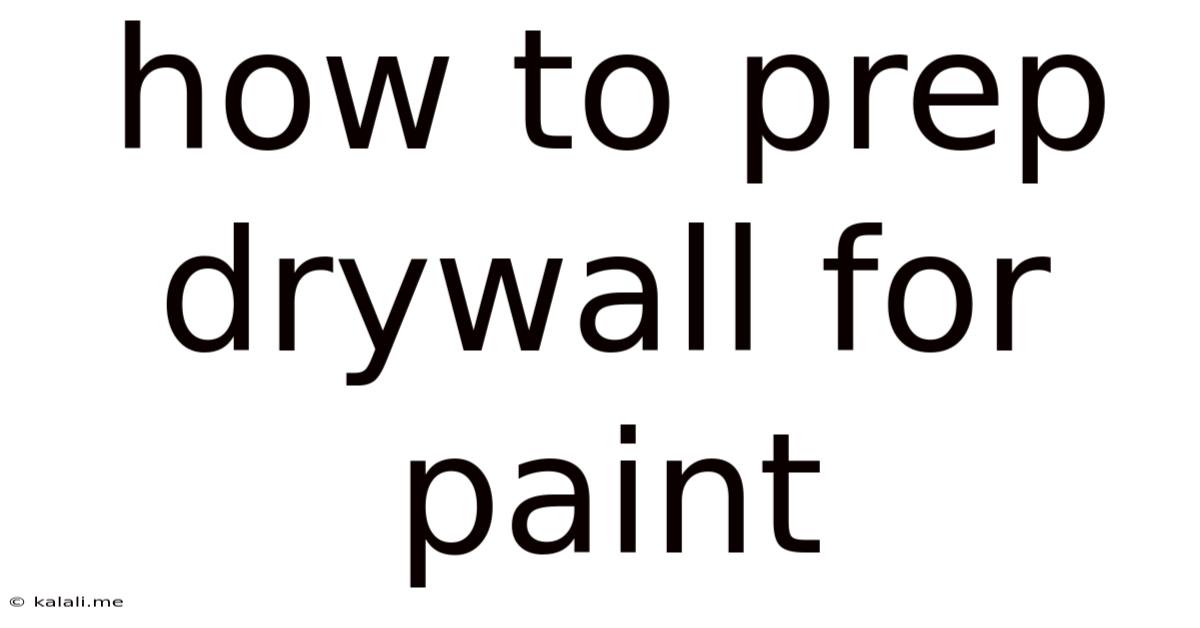How To Prep Drywall For Paint
Kalali
Jun 09, 2025 · 3 min read

Table of Contents
How to Prep Drywall for Paint: A Comprehensive Guide to a Perfect Finish
Getting ready to paint your drywall? Don't rush into slapping on the paint! Proper preparation is key to achieving a smooth, professional-looking finish that lasts. This comprehensive guide will walk you through every step, from patching holes to priming, ensuring your paint job is flawless. Ignoring these steps can lead to uneven paint application, visible imperfections, and a final product that looks far less impressive than it could.
1. Assessing Your Drywall: Identifying Imperfections
Before you even think about grabbing your paintbrush, carefully inspect your drywall. Look for:
- Holes and Cracks: These need to be filled and sanded smooth.
- Scratches and Dents: Minor imperfections can often be sanded down.
- Loose or Damaged Drywall: Any areas that are unstable need to be repaired or replaced.
- Tape Seams: Check for any gaps or unevenness in the tape. These should be filled and sanded.
- Previous Paint Issues: Peeling paint, bubbling, or uneven texture all require addressing before painting.
2. Repairing Holes and Cracks: The Right Tools for the Job
For small holes and cracks, use a lightweight spackling compound. Larger holes may require drywall compound and possibly even a piece of drywall for more extensive repairs. Follow these steps:
- Clean the area: Remove any loose debris.
- Apply the compound: Use a putty knife to fill the hole, slightly overfilling it.
- Let it dry: Allow the compound to fully dry according to the manufacturer's instructions.
- Sand smooth: Use fine-grit sandpaper (120-grit or higher) to sand the area until it's flush with the surrounding drywall. Wipe away any dust with a tack cloth.
3. Addressing Imperfections Beyond Holes: Sanding and Cleaning
Even after patching, you might need to sand down minor imperfections like bumps, ridges, or uneven texture. Remember to always sand in the direction of the grain of the drywall to prevent scratches. After sanding, carefully wipe away all dust using a tack cloth or a slightly damp sponge. This step is crucial for achieving a smooth paint surface. A lack of proper cleaning can lead to paint adhering unevenly.
4. Priming Your Drywall: The Unsung Hero of Paint Prep
Priming is not optional – it’s essential for a successful paint job. Primer serves several crucial functions:
- Sealing the surface: It seals the drywall, preventing the absorption of paint and ensuring even coverage.
- Improving adhesion: It creates a better surface for the paint to adhere to, preventing peeling or flaking.
- Hiding imperfections: It can help to hide minor blemishes and create a more uniform base.
Choose a primer suitable for your specific needs. For example, you can find oil-based primers for surfaces that will experience moisture or stain-blocking primer to deal with stains.
Apply the primer evenly using a roller or brush, following the manufacturer's instructions for drying time.
5. Final Inspection and Paint Application
Before painting, give your drywall one last thorough inspection. Are there any areas that need further sanding or patching? Once you’re satisfied, you’re finally ready to paint! With your drywall properly prepped, you'll be rewarded with a beautiful, long-lasting paint job.
Remember, proper drywall preparation is an investment in a superior paint finish. Take your time, follow these steps carefully, and enjoy the results of your hard work!
Latest Posts
Latest Posts
-
How Many 1 4 Teaspoons Are In 1 Teaspoon
Jul 02, 2025
-
How Many Tbsp In A Dry Ounce
Jul 02, 2025
-
How Do You Say Grandparents In Spanish
Jul 02, 2025
-
How Many Numbers Are Between 48 To 24
Jul 02, 2025
-
How Many Positions Are There In Sex
Jul 02, 2025
Related Post
Thank you for visiting our website which covers about How To Prep Drywall For Paint . We hope the information provided has been useful to you. Feel free to contact us if you have any questions or need further assistance. See you next time and don't miss to bookmark.